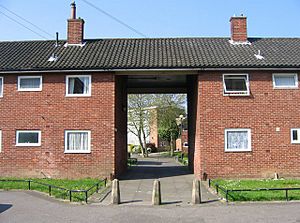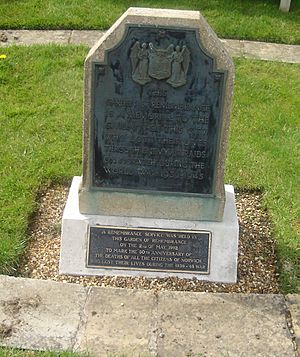Norwich Blitz facts for kids
The Norwich Blitz was a time when the German air force, called the Luftwaffe, heavily bombed the city of Norwich in England during World War II. These attacks on British cities were part of a bigger event known as the Blitz.
Norwich was first bombed in the summer of 1940. But the biggest attacks happened in April and May 1942. These were part of the "Baedeker raids". In these raids, the Germans chose cities for their cultural and historical importance, not for military reasons. The worst attacks on Norwich were on April 27 and 29, 1942. More bombs fell in May and on June 26 and 27. During these raids, Norwich Cathedral was damaged. However, important buildings like Norwich Castle, City Hall, and the Guildhall were not hit. Many homes were destroyed.
Contents
Why Norwich Was Bombed
Norwich suffered a lot of damage from bombs during World War II. Many parts of the old city center and homes around it were hit. Factories and train lines were also damaged. The heaviest bombings happened on the nights of April 27/28 and April 29/30, 1942. These were part of the "Baedeker Blitz".
The Baedeker raids targeted cities like Bath, Canterbury, Norwich, Exeter, and York. These cities were chosen from famous Baedeker tourist guidebooks. The attacks were a way for Germany to get back at Britain. This was because the RAF had bombed the German city of Lübeck earlier that year.
A German radio broadcaster, Lord Haw-Haw, even talked about destroying Norwich's new City Hall. But the City Hall, finished in 1938, was not damaged. Important places that were hit included Morgan's Brewery and Coleman's Wincarnis factory. City Station and the Mackintosh chocolate factory were also bombed. Shopping areas like St Stephen's Street and St Benedict's Street were damaged. This included Bond's department store (now John Lewis) and Curl's department store. The large Harmer's clothing factory was directly hit. In 1945, the city was also a target for V-2 rockets. But all of these rockets missed Norwich.
Air Attacks on Norwich
Tracking the Bombings
The Air Raid Precautions (ARP) kept track of the bombs. They mapped where, how big, and when bombs fell on Norwich. This was part of the UK bomb census. The bombs were marked on a large map using 679 paper labels.
First Bombings
The first bombs fell on July 9, 1940, around 5 PM. Eleven bombs hit the Riverside Works area. On July 30, many other buildings were hit, including large homes on Surrey Street. Even though many raids happened that year, most damage was to homes. Many attacks were at night or early morning. But the most damaging ones, causing many deaths, happened in the afternoon or early evening.
Sixty-one people died in Norwich that year. Twenty-six of them were killed on July 9 during the first raid. In 1941, twenty more people died and twenty-eight were hurt. These were from monthly attacks on the city's outer areas and homes.
The Big Raid of April 27, 1942
Similar raids were happening in Exeter, Bath, Canterbury, and York. Fire bombs caused a lot of the damage. These cities were picked from the famous Baedeker Guidebooks. They were known for their history and culture. The bombings were a direct response to Britain's bombing of the historic German city of Lübeck on March 28.
In Norwich, the raid that started on the evening of April 27, 1942, was the worst of the war. Bombers from German units like KG2 and KG106 carried out the attack. Two nights later, on April 29, another raid happened. This destroyed many buildings in the city center. Two churches were lost on the 27th: St Bartholomew in Heigham and St Benedicts. Their towers still stand today (2019).
The "Hell Fire Raid" in June 1942
This raid was known as "The Hell Fire Raid." Three enemy planes, which were later destroyed, dropped fire bombs and high explosives. This caused several large fires. For example, the thatched department store, Bonds, on All Saint's Green was burned down. The historic Old Boar's Head inn was also destroyed by fire.
St Julian's Church in King Street was hit. So was the Trinity Presbyterian Church in Theatre Street. The Star and Crown public house at 20 Timberhill was destroyed. Many 17th-century buildings were completely wiped out.
What Happened After the Bombs Fell

In the two Baedeker raids, 229 people died and 1000 were injured. In total, 340 people died from bombing throughout the war. This meant Norwich had the most air raid deaths in Eastern England.
Norwich had about 35,000 homes. 2,000 of them were completely destroyed. Another 27,000 homes were damaged in some way. Fewer than 5,000 houses escaped without any damage at all.
Norwich City Station was lost in the bombings. Large parts of St Stephen's Street were also destroyed. The thatched buildings on All Saint's Green, like Bond's department store, were completely burned down. The area where Barn Road and St Benedict's Street met was totally destroyed. Only the city wall remained.
St Paul's Church near Peacock Street and Willis Street was destroyed. Its ruins were removed in the 1950s and 1960s to make way for a new road. Curls' Department store in Orford Place was rebuilt in 1955. St Augustine's School was wrecked. The Norwich Institution for the Blind on Magdalen Street was also damaged.
After the War Ended

Repair work on Norwich began in 1950. The total cost of fixing the damage from the April 1942 raids and other attacks was about £1,060,000. About £280,000 of this was for materials and transport.
See also

